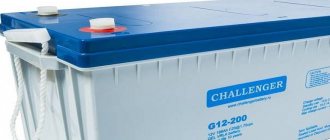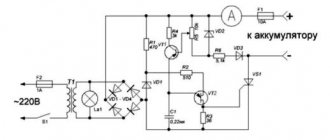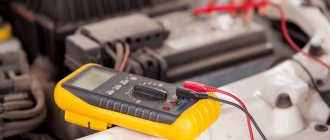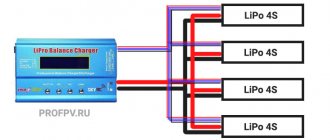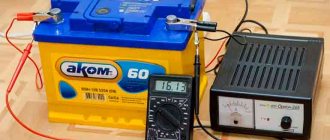Over time, many users of uninterruptible power supplies begin to show interest in how to properly charge the battery from a UPS. There are certain rules that must be followed during the operation of the support device so as not to interfere with the natural course of chemical reactions occurring in the built-in current storage tank. If they are violated, the battery quickly begins to degrade, lose capacity, and in extreme cases may even fail altogether. Accordingly, it makes no sense to use a UPS with a damaged battery to power the user’s computer, his household appliances or other niches that require normalized current.
A LITTLE HISTORY or how it all started
In the early 2000s, I came across an old uninterruptible power supply BACK-UPS 600I from the Basurman manufacturer APC. I got it for free because its batteries were dead. Of course, I immediately tested it, bought batteries recommended by the Basurman manufacturer and “it worked for me”!
Back UPS APC
I wrote about such a UPS in an article about using a UPS to stabilize power.
I couldn’t be happier with him then. Of course, there is no light, but the computer and monitor are working.
But in one unfortunate moment my joy was ruined.
And who do you, Reader, think?.. Fucking hucksters. The first time I replaced two 6V/7Ah batteries with one 12V/7Ah it turned out a little cheaper. But when the battery died again within a year, I started thinking! Firstly, the battery had to be changed once every year or two. Secondly, I wanted the devices connected to the UPS to work not for a few minutes to “properly turn off the power,” but at least until the end of the calculation on the Premier line from Adobe.
This is where naughty thoughts began to arise in my mind: should I connect a 100-amp car battery (to be reliable) to my UPS. Moreover, the traders argued that only gel batteries should be used in the UPS, frightening with Great Punishments those who try to use much cheaper batteries for cars.
But I am a fairly literate person and have learned that you need to know the materiel! Otherwise, something might go wrong with the big bodabum! But you can’t trust traders. Therefore, I took up the study of materiel! As a result of my research, something that I am happy with to this day was born. Namely, I made it so that you can now connect a car battery to a UPS. That is, the UPS and the battery became friends.
Battery behavior when charging
We have described the ideal process in the case when the battery is more or less serviceable. However, more often than not, this does not happen. During operation, the battery's internal resistance increases and its capacity decreases.
A battery with an abnormally increased internal resistance will not be able to operate in a UPS, although it can be charged to the required voltage.
The increase in resistance is most likely due to degradation of the surface of the plates and changes in their chemical composition, so the process of restoring the battery is, in a sense, a lottery. On the other hand, a “hopeless” battery has a chance of recovery.
In my practice, there have been cases when batteries that had run down to 0.5 - 1 V and had been standing for many months were able to be charged to working condition. This was most likely facilitated by distilled water, which changed the chemical environment inside the battery.
In cases of a severely discharged battery, the initial charge current can be several milliamps. Based on the dynamics of charging current growth, we can make a preliminary forecast and prospects for battery recovery.
If it rises to 0.5 - 0.7 A within a few hours, the prospects are good. If the current has increased to several units or tens of mA, and does not increase further, there is little chance of recovery. However, even in this case it is worth fighting.
After several hours of charging, a discharge is needed. It is good to use a 40-80 W car lamp for this.
After several minutes of discharge, you should put the battery on charge and check the charging current. If it has increased from the original purpose and continues to grow, this is a good sign. You can do two or three charge-discharge cycles, controlling the charge current and voltage on the battery. The charge duration can be 1-2-4 hours, discharge 5 - 10 minutes.
If the battery takes a charge and is charging, you should load it with a car lamp and look at its glow. Based on the brightness and duration of the lamp, you can make a preliminary conclusion about the condition of the battery.
If, when connecting a lamp, the voltage at its terminals noticeably sags (and the lamp does not glow at full intensity), this indicates an increased internal resistance of the battery.
In this case, it is impossible to use it in a UPS.
I tried to reduce the internal resistance of the batteries by adding an additional amount (2-3 ml to each jar) of distilled water. But in no case was the attempt successful. True, I did not control the magnitude of this resistance. But I came to the following conclusion: if the battery cannot work normally in a UPS, adding an additional volume of distilled water will not help the situation.
There may be cases where there is increased internal resistance in one bank. There was a case when, after several minutes of discharge by a lamp, the outer surface of the battery heated up locally in a certain place. In the jar where the external battery terminal was.
Adding water to this particular jar did not help the situation either.
INSTEAD OF A FOREWORD. Types of batteries
Uninterruptible power supplies (UPS) use gel batteries. And there are good reasons for this. I will not list them all, but I will explain the main ones. Imagine an office secretary with a twenty-kilogram battery in her hands. It's a funny sight, isn't it?..
There are not so many technically competent specialists who thoroughly know what electric current is. And specialists who know how a switching power supply works, how an inverter converts direct voltage into alternating voltage and even less. The average computer user is not interested in this. That's why gel batteries were created. Inside such a battery, of course, there is no hair gel or helium, as an inexperienced secretary might think from the name. Inside there is the same sulfuric acid and the same lead, as in a regular car battery that has been familiar to us for more than a century. Only there is still a fine mesh with very, very small cells made of non-conductive material, which holds the acid like a sponge in its pores. Also, such a battery does not require maintenance.
Imagine the same secretary with a hydrometer in her hands, with a jar of electrolyte and a bottle of distilled water on the table. UPS manufacturers strive to protect themselves from lawsuits and claims. Therefore, they use the safest batteries in their devices from the point of view of use by an inexperienced consumer. But we know the materiel :)).
I will not go into the weeds and touch in great detail on existing types of batteries, the issue of battery operation under different conditions (huge starting current, long-term load, constant undercharging, overcharging, electrolyte boiling off, deep discharge, operating temperature, etc.), although some -which of these concepts will be discussed in more detail further in the text. I simply guarantee and responsibly declare, based on my practical experience, that under certain conditions it is possible to use cheap starter batteries in a UPS instead of expensive gel batteries! So, let's begin!
Battery for a UPS - briefly about the importance of choosing the right battery for a UPS
In the event of a power outage, the UPS battery switches to battery power to provide a continuous power source for the entire length of the battery. Battery life varies by system and depends on how much power you use. Battery backup gives you time to shut down sensitive hardware, servers, or even game consoles without losing data or progress. Various UPS systems also provide some level of protection against other power problems.
A UPS is, at its core, a battery backup system that provides power long enough for equipment to properly shut down when the utility power fails. This helps prevent data loss and minimizes the stress caused by a hard shutdown of your electronic equipment.
A UPS battery is also a surge protection device that protects connected devices from power problems such as power surges or abnormal voltage that can damage, shorten the lifespan, or affect the performance of electronic equipment and devices.
Battery THEORY. Required for studying!
Here I will only touch on the theory of MAINTAINED lead-acid starter batteries used in cars and produced in compliance with all technological production standards (in other words, not produced in the Chinese basement of Uncle Liao or in the janitor's room of the former house of Ippolit Matveevich in Stargorod). They are the cheapest but at the same time the most “knowledge-intensive” to operate.
If they are used and maintained correctly, but most importantly, charged correctly, they can last more than 15 years, or withstand more than FOUR HUNDRED 100% discharge-charge cycles or more than a THOUSAND 30-40% discharge-charge cycles! It's been tested, I guarantee!
Summary of Battery Reconditioning Procedure
So we want to restore the battery. Add two to three milliliters of distilled water to each jar, wait an hour or two and put it on charge. We periodically monitor the charge current and voltage on the battery.
First, we charge with a current of no more than 0.1 of the battery capacity. We make sure that the charging current does not exceed the maximum values for this battery, and the voltage at the terminals is no more than 15 V.
After several hours of charging, discharge the car lamp for several minutes and look at its glow (or lack thereof).
If after two or three charge-discharge cycles the condition of the battery has not noticeably improved, we scrap the battery.
Finally, we note that batteries should be stored in a charged state in a cool place. You can read more about batteries in this article.
You, dear readers, can rightly judge that there is no point in messing with dead batteries, since the result is unpredictable. On the other hand, when a hopelessly diseased piece of hardware can be brought into working condition, there arises, as one famous figure said, “a feeling of deep satisfaction.”
After reading it, you will understand that repairing uninterruptible power supplies is not as difficult as you might think!
PLAstic
MIHALYCH
DIVAS
The charging voltage of a 12V lead battery is 14..14.8 V. The charging current should be limited to 0.3C, that is, in this case it is 2.2A.
Lead-acid batteries are fundamentally different from alkaline ones in that they are charged not by current, but by voltage with current limitation. That is, the charger should not produce a voltage greater than 14.8V and a current greater than 0.3C. That is, while the battery voltage is less than 14.8V, a current of 0.1..0.3C should flow through it, and when the voltage reaches 14.8V, the charge continues with a weak current, but the voltage should not increase further. That is, limiting the current with a resistor is not suitable - you need a current stabilizer (limiter) and an output voltage stabilizer.
In general, there is another way - to charge the battery from the UPS with the same UPS. IMHO, the simplest and most reliable method, because everything is already calculated for you.
The principle of operation of the battery
The battery has two extreme operating states - completely discharged and fully charged. Let me touch on these two states in more detail. Any car battery consists of 6 “cans”. This is slang for a vessel that contains plates and acid. The plates in these vessels are connected in series. Here is the first fundamentally important point. One “can” also has two extreme operating states - completely discharged with a voltage of 2.00 volts and fully charged with a voltage of 2.40 volts.
- The voltage of a completely discharged battery is 12.00 volts (6 x 2)
- The voltage of a fully charged battery is 14.40 volts (6 x 2.4)
How can this be, you ask? After all, the voltage on the battery is never more than 13 volts. And you'll be right. The voltage on a fully charged battery will be in the range of 12.75 - 12.80 volts with an electrolyte density of 1.26 g/cc and at a temperature of 25 degrees Celsius. But where does 14.4 volts come from?.. During charging and discharging, complex chemical processes occur in the battery, which last for some time after the charger or load is disconnected. This can be called chemical inertia. The density of the electrolyte changes accordingly.
The temperature in the battery can also be different (from -40 to +50). When some processes occur in the battery, all its indicators change. And they are interconnected. A voltage of 12.75 - 12.80 volts is the “rest voltage” of a fully charged battery. For a fully charged battery, the voltage will drop when a load is connected. When the load is turned off, the voltage will again tend to the same 12.75 - 12.80 volts. But since a certain amount of energy was given, the voltage (depending on this amount) will not rise to 12.75 - 12.80 volts.
The battery is considered discharged by a certain percentage. Accordingly, when charging, the voltage increases, and when charging stops (the processes inside the battery also stop), the voltage again tends to the resting voltage.
And here on the podium appears His Majesty Electric Current, measured in amperes. The greater the load current on the battery, the more energy the battery will release per unit time. And it will discharge accordingly. The battery's electrical capacity is usually written on it.
The electrical capacity of the battery is the product of the direct current of the battery discharge and the discharge time at the rated voltage (for a car battery this is 12 volts).
Accordingly, in an hour, a battery with an electrical capacity of 60 Ah can deliver 60 amperes with a voltage of 12 volts before it is completely discharged. In practice, it looks like this: if the battery is loaded with a current of 60 amperes for one hour, its voltage will drop from 12.75 - 12.80 volts to 12.00 volts. This is the fundamental basis of battery operation.
In practice, the battery has one very unpleasant feature. Self-discharge current. Moreover, this current increases if the battery is in the sun and the temperature of the electrolyte in it rises. But the battery capacity also increases accordingly. But in winter, the self-discharge current decreases. But the battery capacity decreases accordingly. Therefore, there are standards for the operation, storage, and preservation of batteries that take into account all these factors.
For a new battery with an electrical capacity of about 60 Ah, the self-discharge current at a temperature of 25 degrees Celsius usually does not exceed 20 milliamps. This means that at room temperature the battery can be discharged to half its electrical capacity in four to five months. As the battery ages and is used intensively, the self-discharge current increases with each discharge-charge cycle. When the battery is loaded, the self-discharge current and the load current are summed up. But what about 14.40 volts, YOU persistently ask again?... Here there is a second fundamentally important point.
Preliminary preparation for battery restoration
The first step is to fill the battery with a small amount of distilled water. A 12-volt battery has 6 series-connected jars, each of which produces a voltage of about 2 V. 3 milliliters of distilled water must be poured into each jar.
In this case, it is convenient to use a medical syringe with a volume of 10-20 “cubes” with divisions. To gain access to the banks, you need to open either the common cover on the side of the terminals or the round covers opposite each bank. It is convenient to use a screwdriver with a thin narrow blade.
It is necessary to insert the screwdriver blade into the corresponding recesses and pry off the cap. After restoration is complete, it can be glued with quick-drying “cyanopane” glue or similar.
After the lids are removed, you also need to remove the rubber stoppers that seal the openings of the cans.
Cans should be kept open during charging!
Before pouring water, you need to carefully look inside the jars. In some batteries, the can outlet is covered with a transparent film. If it is there, you need to carefully pierce it with a thin awl.
This should be done carefully so as not to damage the battery plates.
When pouring water, do not insert the syringe needle too deeply, otherwise its outlet hole will become clogged with grease from the plates. After the water is poured in, you should wait a couple of hours so that it is distributed in the space of the cans.
Battery charging principle
There are two ways to charge the battery:
- DC charging
- Constant voltage charging
It is impossible to say which one is better. It all depends on what you want to achieve. Fast charging or full charging. I prefer to charge the battery using the second method. And then I will justify my position.
A DC charger is much simpler in design and cheaper to manufacture. A constant voltage charger is much more complex in design and more expensive to manufacture. Those who charged batteries with old Soviet chargers (by the way, very remarkable in their technical parameters and reliability of execution and operation) know the theory.
If the battery is completely discharged, unscrew the caps on the battery, connect the battery to the charger, set the current to one tenth of the battery capacity and charge for 12 hours. After 12 hours, we reduce the current by half (to one twentieth of the capacity) and recharge for an hour or two, until the electrolyte begins to “boil”, turn off charging. Boiling of an electrolyte is the process of releasing hydrogen vapor from it. Ideally, the electrolyte should not boil. Because then you will have to take a hydrometer, measure its density and add distilled water. Therefore, you need to constantly reduce the current.
If the battery has lost its capacity due to harsh use, deep discharge or simply aging, it can be charged in a couple of hours. And the electrolyte will begin to boil an hour after connecting the charger.
Constant current charging means that the voltage increases while charging. And as soon as the voltage exceeds 14.40 volts, the electrolyte will boil anyway. What to do in this case?.. Option one is to monitor the charging process by constantly lowering the current, keeping the charging voltage at 14.40 volts. Option two is to use an automatic machine that monitors this itself. But it monitors the voltage, lowering the charge current as needed. This is charging in the second way - constant voltage.
The second fundamentally important point is the correct charging of the battery to ALL 100% of its electrical capacity:
YOU CAN FULLY CHARGE THE BATTERY (TO 100% OF ITS ELECTRICAL CAPACITY) WITHOUT BOILING OUT OF THE ELECTROLYTE ONLY WITH A VOLTAGE OF 14.40 VOLT!
I prefer to charge the battery with a constant voltage of 14.40 volts. The reality is that charging a battery to 100% is quite difficult. When the battery has reached 95% of its capacity, its charging current is very small, and at 99% it is simply scanty and can be only 30 milliamps. I will note one detail - this is all on the verge of boiling the electrolyte. Theoretically, the electrolyte begins to boil at a charge voltage of 14.41 volts, provided that the battery is made perfectly, and does not boil at 14.40. In practice, it can be either 14.38 volts or 14.42. It all depends on the battery manufacturer and individually for each specific battery. But I hope you, dear reader, got the point.
The disadvantage of voltage charging is the charging time. Typically, the battery reaches its full charge capacity (100%) in more than a day. The charging current at the initial stage is very important here. You can charge at the initial stage with a current of one-fifth of the capacity. Then the charging time will be reduced. Same as battery life, but not significant. No one has canceled the charging theory. It is preferable not to exceed the charging current of more than one tenth of the battery capacity. The choice is yours, reader.
How to charge a UPS battery: the difference in the method of charging different types of batteries
A standard battery requires a constant current, the voltage steadily increases to a certain value, the electrolyte boils and charging stops. If you charge the UPS battery in the same way, the boiling electrolyte will cause an explosion. Therefore, the amount of current for charging should be equal to one tenth of the battery capacity, it should be reduced to 20-30 mA and limited. The voltage should not exceed 15 V and should not change during charge replenishment.
How to properly charge a UPS battery
Proper charging of the UPS battery provides it with a much longer service life than specified by the manufacturer, without loss of efficiency.
First recharge
Uninterruptible power supply units are supplied from the factory charged, but may arrive at the user half or completely discharged. The device has a built-in self-testing system, which is activated before the start of each operating cycle and reports that the battery is fully charged.
Can a car battery be used for a UPS?
And now we come to the crux of the matter. How to use a starter battery for a car in a UPS. My BACK-UPS 600I UPS fits this perfectly!
The very first UPSs from APC of the Back UPS series charged the battery exactly according to the principle of charging the battery with constant voltage. There is a microcontroller for controlling battery charging. The estimated battery capacity for my UPS is 7 Ah. The charge current is 350 milliamps at the initial stage. At the end, the current drops to 10 milliamps (in fact, to a current slightly higher than the self-discharge current). Newer UPSs charge differently. I tested the newer model Back-UPS CS 650 (I even wanted to buy it), but this iron beast keeps the voltage at 13.7 volts. When the charge current exceeds a certain parameter, this muck displays the Replace Battery icon on the front panel.
UPS APC backups-650
The operating principles of Uninterruptible Power Supply (UPS) are described in detail by me in this article.
Of course, it can also be used with a car battery, but with a large-capacity battery there may be problems with undercharging. You will have to use external charging with it (I will discuss this issue below, in the Practice section). And the voltage of 13.7 volts is not enough to charge the battery 100%. Therefore, I don’t need such a UPS for nothing. But with my BACK-UPS 600I UPS you can use a battery of at least 150 Ah. Yes, when the battery is completely discharged, it will charge it with a current of 350 milliamps for several days. But it is guaranteed to charge 100%. But in order to save time, you can again get out of this situation using external charging.
Charging the UPS battery for the first time: what you need to know
When purchasing an uninterruptible power supply, it is important to understand how to initially charge the battery in the UPS. As a rule, during the time from the moment the equipment is manufactured until it is purchased and put into operation by the user, the factory charge of the battery is discharged. That is, the new UPS will arrive at your home, office or business in a discharged state. This means that the batteries will not be able to reliably maintain power to the protected devices when an uninterruptible power supply is immediately installed under the load. In addition, the device is programmed to perform self-tests before each start-up. The self-test procedure will end with a message indicating that the battery module is faulty and requiring its replacement.
PRACTICE charging the battery in a UPS. We study the materiel
So, Reader, we have come to the heart of the matter. I'm glad to present what my Back UPS 600I has become over 14 years of use. 9 of them I use it with lead-acid batteries for the car.
Appearance of the UPS panel based on Back UPS 600I
I hasten to immediately convince the skeptics with a fear of hydrogen. Both gas outlet holes on the sides of the battery were sealed with latex from a condom (if anything happens, it will simply inflate). The caps on the cans are also screwed tightly. But during 9 years of operation there were no incidents. Therefore, now they are filled with silicone glue. I use two batteries. The batteries are connected with a common minus and a switched plus. From the inside it looks like this:
Converted UPS, view of the circuit from the inside
On the front panel we see a digital voltmeter that shows a charge voltage of 14.44 volts and an ammeter that shows nothing. This is my standard operating mode. We'll find out why it doesn't show anything below.
Now again, just a little bit of history. What you, Reader, see in the photo below are my very first devices for monitoring UPS. This is a dial voltmeter with an extended scale (measures voltage from 10 volts to 15 volts) and an ammeter with a homemade shunt. I needed to see both the current when operating from the battery and the charging current. If you need to make the voltmeter show the voltage not from zero, but from the desired voltage, the scale can be stretched using voltage dividers; there are diagrams on the Internet.
Pointer instruments for measuring current and voltage
They were made many years ago and served faithfully before Aliexpress became a symbol of the era. Then I got wonderful and, most importantly, very accurate instruments (ammeter + shunt for it and a voltmeter) at inexpensive prices. This is what the UPS looks like with the ammeter turned on:
Digital voltmeter and ammeter
It shows the charging current. As you can see, the current is not large - only 50 milliamps. This is the UPS battery charging controller. One detail is worth noting. Only after I installed a digital voltmeter of such accuracy did it become clear how the charge controller works. The dial voltmeter could not record this.
The charge voltage periodically varies from 14.37 volts to 14.47 volts and can be at the same level for half an hour or 30 seconds. The charging current depends on the connected battery. If a battery with a capacity of 17 Ah is connected, the charging current is within ten milliamps. But here it’s impossible to say for sure. This is on the verge of instrument error. Maybe 14 milliamps, maybe 6 milliamps. One thing I can say for sure is that it is different for batteries of different capacities.
But the ammeter is not as simple as it seems. The beauty of it is that it can show electrical current in two directions. It will show the charging current and discharge current but with a minus sign. Now I will connect a load of about 180 watts to take 20 amperes from the battery. You can immediately see how the voltage dropped and how the ammeter began to show battery discharge with a negative value:
Ammeter shows discharge
I configured the UPS for myself based on the fact that I would draw no more than 20 amperes of current from the battery. A load of 90 watts from 220 volts loads the battery within 10-11 amperes. But in fact, I now have two servers on the UPS, a router and a switch. This whole facility consumes about 30 watts from 220 volts, and from the battery within 4-5 amperes. Battery 58 Ah.
It is guaranteed that all this can work without electricity for about 7-8 hours (depending on the load on the servers). As soon as the electricity goes out, I receive an SMS and I can turn off the servers remotely. But I don’t think this will be necessary. In seven hours I will appear and switch to the second battery :)), using a button manually. And while this is all working, I’ll remove the battery from the car and connect it instead of the first one. That's another 7-8 hours. Well, within a day the electricity supply will be restored for sure. So far there have been no such force majeure events. :)) Well, if they do, I’ll splurge on a 100 amp battery. True, you can’t put it in the car. By the way, this is one of the reasons why I don’t use a battery with a larger capacity than my car can “swallow.” Although, as you can see, Reader, the system allows you to use a battery with a capacity of at least 1000 Ah.
Well, the readings a couple of minutes after the UPS power switched back to 220 volts. As you can see, the voltage is 13.08 volts and the charging current is 140 milliamps:
Charge after a small discharge
The connection diagram allows you to INDEPENDENTLY charge one of the batteries while the other is in use. Once every six months I switch between batteries in order to somehow equalize the aging process of both batteries. Wires 6 sq. mm.
Diagram of the battery charging system and UPS
It is worth noting that when the length of the wires is more than a meter, you need to use a larger cross-section. For myself, I calculated that with an operating current from the battery of 12-15 amperes and a wire length of 40 centimeters, the voltage drops by 0.008-0.015 volts. This is about an extra 3-6 minutes of battery life. At 7 hours this is insignificant. Accordingly, the shorter and thicker the wires from the battery to the UPS, the better, especially at high load currents.
The dependence of the voltage drop on the length of the wire and its cross-section can be seen here.
The wonderful battery selection switch button allows you to connect an external charger. Also, this key, with some skill, allows you to switch batteries while the UPS is running from the battery. This has also been verified. Modern switching power supplies for computers hold the load if the mains voltage is lost for 0.8 - 1.2 seconds. And this is just enough to quickly “switch” the key to another battery when the voltage on the battery drops to a critical level.
The ammeter and voltmeter draw very little current. If you turn off the display backlight LED, the devices consume about one milliampere (I even specifically measured how much the voltmeter consumes by calling up units on the display - this is a smaller number of LCD segments), the device consumed 900-odd microamperes at a supply voltage of 11.11 volts. With the LED on (when the display is lit) about 3 milliamps. And is it important. After all, it is connected to the battery directly. I generally made the ammeter switchable, because its power is connected to the 220 Volt output of the UPS. I want to clarify here. The ammeter's power supply must be galvanically isolated from the circuit in which it takes readings. Its supply voltage ranges from 6.5 volts to 15 volts. I haven't found a suitable power supply for it. As it turned out, a power supply with parameters of 6-12 volts, designed for a load of 10 milliamps, is not so easy to find. But I didn’t have the patience to do it myself. I really wanted to quickly connect it instead of the switch that was there before. So I took a 400 milliamp, 7.5 volt phone charger and connected it to the 220 volt UPS output and made it completely switchable. This is to reduce the load on the 220 Volt output of the UPS when it is running on battery power. The voltage and amperage control key turns off the ammeter completely, and the voltmeter turns off the backlight, minimizing battery energy consumption. Well, in general, that’s all the explanations for the UPS control keys.
Digital voltmeter and ammeter with backlight turned off
Battery behavior when charging
We have described the ideal process in the case when the battery is more or less serviceable. However, more often than not, this does not happen. During operation, the battery's internal resistance increases and its capacity decreases.
A battery with an abnormally increased internal resistance will not be able to operate in a UPS, although it can be charged to the required voltage.
The increase in resistance is most likely due to degradation of the surface of the plates and changes in their chemical composition, so the process of restoring the battery is, in a sense, a lottery. On the other hand, a “hopeless” battery has a chance of recovery.
In my practice, there have been cases when batteries that had run down to 0.5 - 1 V and had been standing for many months were able to be charged to working condition. This was most likely facilitated by distilled water, which changed the chemical environment inside the battery.
In cases of a severely discharged battery, the initial charge current can be several milliamps. Based on the dynamics of charging current growth, we can make a preliminary forecast and prospects for battery recovery.
If it rises to 0.5 - 0.7 A within a few hours, the prospects are good. If the current has increased to several units or tens of mA, and does not increase further, there is little chance of recovery. However, even in this case it is worth fighting.
After several hours of charging, a discharge is needed. It is good to use a 40-80 W car lamp for this.
After several minutes of discharge, you should put the battery on charge and check the charging current. If it has increased from the original purpose and continues to grow, this is a good sign. You can do two or three charge-discharge cycles, controlling the charge current and voltage on the battery. The charge duration can be 1-2-4 hours, discharge 5 - 10 minutes.
If the battery takes a charge and is charging, you should load it with a car lamp and look at its glow. Based on the brightness and duration of the lamp, you can make a preliminary conclusion about the condition of the battery.
If, when connecting a lamp, the voltage at its terminals noticeably sags (and the lamp does not glow at full intensity), this indicates an increased internal resistance of the battery.
In this case, it is impossible to use it in a UPS.
I tried to reduce the internal resistance of the batteries by adding an additional amount (2-3 ml to each jar) of distilled water. But in no case was the attempt successful. True, I did not control the magnitude of this resistance. But I came to the following conclusion: if the battery cannot work normally in a UPS, adding an additional volume of distilled water will not help the situation.
There may be cases where there is increased internal resistance in one bank. There was a case when, after several minutes of discharge by a lamp, the outer surface of the battery heated up locally in a certain place. In the jar where the external battery terminal was.
Adding water to this particular jar did not help the situation either.
CHARGING with an external charger
Now I want to separately touch upon the correct charging of the battery of my UPS. As I mentioned above, I will tell you why I prefer charging the battery with constant voltage. I’ll touch on this issue using my charging as an example. It looks like this:
Proper battery charging
Its diagram can be found in Radio magazine. Many thanks to my dad, who found it and then soldered it, and to the author of this development - M. Shumilov (https://www.radioway.ru/2009/01/kompyuternyi_blok_pitanija_-_zarjadnoe_ustroistvo_.html) for a competent and very useful device made from a computer block nutrition. Charging is quite complicated to manufacture and configure. But after this process, it will delight you with its accuracy and ease of charging the battery at a guaranteed 100% capacity. The indicator shows, in addition to current, voltage and charging power, the watt-hours spent on charging. This is what it looks like from the inside:
What does a charger circuit based on a computer power supply look like?
Charge voltage 14.40 volts (adjusted during setup). Precisely so that it is not 14.39 and not 14.41! It is important. The charging current is limited to the range of the battery that you plan to charge. My current is limited to 6.5 amperes. For my needs this is the optimal current.
This type of charging can charge batteries with a capacity from 20 Ah to 80 Ah. Of course, you can also charge a 150 Ah battery. But charging time will be about two days. When the battery is connected, the voltage drops and the charging current is maximum. Here you should pay attention to the fact that if you do not limit the charging current, for the first few seconds it may be the same as the battery capacity. As the battery charges, the voltage tends to 14.40 volts and the charging current gradually drops. As soon as the voltage rises to 14.40 volts, we can see one of the main parameters of the battery, which is not so easy to find out - SELF-DISCHARGE CURRENT. Using it you can find out how much the battery is worn out and what to expect from it in winter.
Another advantage of this charging method is that you will never overcharge the battery. It can stand on charge for at least 3 months. The electrolyte will never boil and it will be charged 100%. Unfortunately, industrial chargers of this type are very expensive, and the built-in ammeter with voltmeter is direct proof that the charging is really not hacky. Unlike the shitty Bosh and other Vart, where the control indication is carried out by LEDs that light up due to some case of flatulence from the manufacturer. Now I accurately and without any confusion explained the figure of 14.40 volts.
After the charging process, you need to wait about 2-6 hours (depending on the battery capacity) until the battery comes to a resting state. The voltage will be about 13 volts. And within a day or two (when all chemical processes inside stop completely), the battery voltage will drop to a voltage of 12.8 volts. The process of self-discharge will begin. Now, I hope, it has become clear why I plugged the holes in the battery and do not worry about harmful fumes during charging. Periodically, previously once every six months, now once every couple of years, I test and service the battery. I use a hydrometer to check the density of the electrolyte in the jars and its level. Well, accordingly, I recharge the backup battery with external charging.
Preliminary preparation for battery restoration
The first step is to fill the battery with a small amount of distilled water. A 12-volt battery has 6 series-connected jars, each of which produces a voltage of about 2 V. 3 milliliters of distilled water must be poured into each jar.
In this case, it is convenient to use a medical syringe with a volume of 10-20 “cubes” with divisions. To gain access to the banks, you need to open either the common cover on the side of the terminals or the round covers opposite each bank. It is convenient to use a screwdriver with a thin narrow blade.
It is necessary to insert the screwdriver blade into the corresponding recesses and pry off the cap. After restoration is complete, it can be glued with quick-drying “cyanopane” glue or similar.
After the lids are removed, you also need to remove the rubber stoppers that seal the openings of the cans.
Cans should be kept open during charging!
Before pouring water, you need to carefully look inside the jars. In some batteries, the can outlet is covered with a transparent film. If it is there, you need to carefully pierce it with a thin awl.
This should be done carefully so as not to damage the battery plates.
When pouring water, do not insert the syringe needle too deeply, otherwise its outlet hole will become clogged with grease from the plates. After the water is poured in, you should wait a couple of hours so that it is distributed in the space of the cans.
ABOUT THE CHARGE TABLE and more
Now, perhaps, it is worth giving an explanation to the table, which characterizes the degree of charge and discharge of the battery. I explained everything about charging above. Now for an explanation of the discharge.
Important points in battery charging and discharging processes
As you can see, I have noted that the battery is discharged to zero when the voltage on it drops to eight volts. This is a rather subtle and also important question. Let me immediately explain the term “deep discharge” that I use later in the text. The battery goes into a state of deep discharge when its resting voltage is below 11.35-11.40 volts. This is the upper limit of deep discharge. As I said above, after disconnecting the load, the voltage on the battery begins to increase.
It is very important that after 2-6 hours, depending on the battery capacity, this voltage rises to 12.00 volts. This means the battery has not gone into a “deep discharge”. Although, in my experience, even if the battery is briefly discharged to 11.90 - 11.85 volts, nothing bad will happen if it is immediately put on charge. And manufacturers often write the short-term inrush current next to the capacitance. This current instantly sends the battery into a deep discharge, but, as you can see, the battery can withstand this and serves in the car for 5-6 years. When starting the starter in a car, the battery is loaded with currents of up to 200 amperes and the voltage drops to 9 volts. It is important how long the battery is under LOAD in a deep discharge.
The UPS manufacturer sets the lower shutdown threshold at full load on the battery. Therefore, in my case it is about 7.55 volts with a load of about 30-35 amps. I checked on a dead battery when I tested the entire system. At 7.55 volts, the UPS is completely disconnected from the battery and “goes out”. And 8 volts in my table is indicated for full load. This is a “memo to self.” I did not rely on 7.55 volts to leave some kind of safety buffer. In general, it is better not to let the battery discharge until the voltage drops to such a low level. The battery sags in voltage more under full load than under 50% or 30% load. As soon as the load disappears completely, the voltage on the battery rises abruptly and then continues to rise more and more slowly until the actual discharge voltage.
When I tested the UPS, with a 20-amp load on the battery, when the voltage dropped to 8 volts, I reduced the load to 9 amperes, the voltage instantly rose to 10.6 volts, while continuing to slowly decrease. This is calculated empirically. If you discharge the battery with a load of 10 amperes, then the lower value will not be 8 volts, like mine, but more (it can be 8.4 volts, for example, or 9.0 volts) - I repeat, this is calculated empirically. If the load on the battery from the UPS is 10-20% of the calculated value, accordingly the voltage “sags” less, but the load on the battery is longer lasting. And accordingly, the battery remains in a deep discharge under load longer. But this is already “killer” for the battery.
Therefore, you need to try not to let the battery become deeply discharged and, if possible, if it comes to this, immediately charge it. And when, during a power outage, we try to disconnect some additional devices from the UPS, increasing the operating time of the UPS from the battery, thereby forcing the battery to work longer in a deep discharge. Therefore, this issue needs to be resolved more fundamentally, coming from the other side - connecting a 150-amp battery :)) and not letting it discharge below the voltage calculated for a certain amperage.
When I described the operating time of my consumers (router, servers and switch) as 7-8 hours, this is actually 2-3 hours the battery will work in a deep discharge. And accordingly, its life time will be reduced quite significantly, but not so much that it will no longer work. But buying a car battery with a capacity of 58 Ah (operating time 2-3 hours) for 32-34 euros is much more pleasant than a battery with a capacity of 7 Ah (operating time 5-10 minutes) for 18-20 euros. Feel and savor the difference ;))... And the car battery is MUCH more durable, more serious and more reliable than the gel “battery” that comes “included” with the UPS. Direct proof is the service life of my battery :). Yes, and a gel “battery”, after working for 20-30 minutes in a deep discharge, actually dies immediately - the plates inside it begin to deteriorate and its electrical capacity drops significantly, unlike a car battery, where the loss of electrical capacity from working in a deep discharge for 2-3 hours is measured in percentages .
I would also like to draw the Reader’s attention to one point in the operation of this particular UPS. Comfortable operation with BACK-UPS 600I will be with a load of up to 200 Watts from a 220 volt AC network. Accordingly, about 25 Amperes will be drawn from the battery. At higher currents, the ceramic resistor starts to get very hot. If you want to provide autonomous power to electrical appliances up to 500 watts, you need a UPS designed for high power. And I would also like to draw your attention to the fact that the UPS-shek inverter over 800 volts operates from TWO batteries connected in series (12+12=24 volts) due to design features. I have not seen a kilowatt UPS powered by a single 12 volt battery.
PERHAPS, SELLERS OF SEALED, MAINTENANCE-FREE BATTERIES FOR UPS, AFTER READING EVERYTHING WRITTEN ABOVE, WILL NOT BE SATISFIED. I HAVE ONLY ONE ARGUMENT, BUT REINFORCED CONCRETE – IT’S ALL BEEN WORKING STABLE FOR MANY YEARS. THE LAST TIME I BUYED A BATTERY FOR A UPS SEVEN YEARS AGO (TWO PIECES), ONE IS STILL WORKING, THE SECOND IS NOW WORKING IN A CAR AFTER SERVING IN A UPS FOR FIVE YEARS.
First charge rules
So, how to charge the UPS for the first time:
- Connect it to AC power by plugging it into a wall outlet. You should turn off all consumers and do not turn on the device itself.
- You should charge the device for about 24 hours, keeping it connected to the mains the entire time.
- When this time has expired, you should connect the UPS to the load, i.e. turn on the consumers. You should wait until the batteries are discharged and repeat the cycle. Only after this can you use the device without any problems.
- During the charging process, you should carefully monitor the current and voltage readings on the ammeter - most modern devices of this type have one. When charging, the current should decrease and the voltage on the battery should increase. All this should be constantly and carefully monitored. The charging process should be considered completed approximately when the voltage is more than 12.5 volts.
Download
- Theory and practice of using batteries. Types of batteries. The best thing you can read on the topic is • Selection and operation of batteries for autonomous and backup power supply. / Theory and practice - in detail in simple language, pdf, 6.97 MB, downloaded: 1663 times./
- • Dasoyan, Novoderezhkin, Tomashevsky. Production of electric batteries / The book describes the production of electric batteries (lead-acid, alkaline, silver-zinc, etc.), provides the necessary information about the device, the most important electrical and operational characteristics, pdf, 19.88 MB, downloaded: 879 times./ .
Basic rules for charging lead-acid batteries
To know how to charge a UPS correctly, it is enough to know only two rules for charging lead-acid batteries:
- The initial recharging current at its nominal value in Amperes should not be more than 3-30% of the capacity of the battery itself in Ampere-hours.
- Make sure the charger voltage matches your battery specifications.
In order for an expensive UPS battery to last its maximum service life without failures or loss of efficiency, the recharging current should be slightly less than recommended.
You can calculate how much to charge your uninterruptible power supply yourself. To do this, divide the battery capacity in Amp-hours by the current in the charger in Amp.
An example of converting a UPS to a car battery
Reader BoB4uk took the advice outlined in the article and assembled a similar device. More details in the comments around March 17, 2022.
UPS panel in different modes
Reworked diagram by the author
